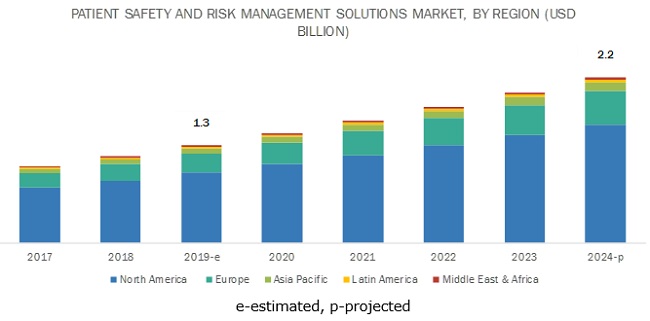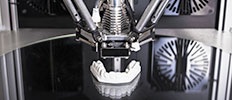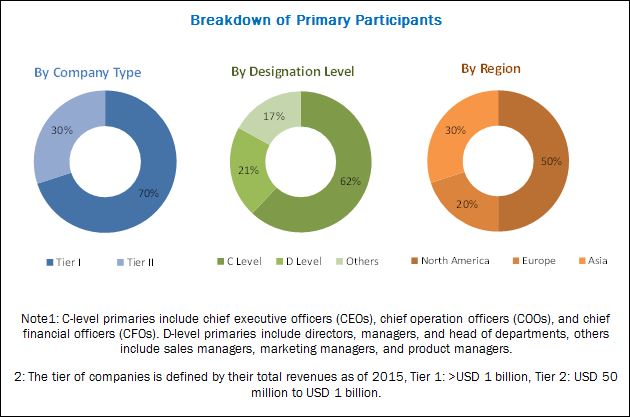healthcare market
Sepsis Diagnostics Market: Lack of Standard Protocols and Awareness
The global sepsis diagnostics market size is expected to reach USD 700 million by 2025 from USD 429 million in 2019, at a CAGR of 8.5%
The demand for sepsis diagnostic products is expected to grow mainly due to factors such as the increasing public-private funding for target research activities, the growing burden of infectious diseases, the rising number of sepsis incidences, and growing government initiatives for creating sepsis awareness.
The blood culture segment accounted for the largest share of the market, by technology, in 2019
The sepsis diagnostics market, by technology, the market is segmented into blood culture, immunoassays, molecular diagnostics, flow cytometry, microfluidics, and biomarkers. In 2019, the blood culture segment accounted for the largest share of the market. This share can be attributed to the low cost of microbiology techniques and the extensive use of blood culture methods for the diagnosis of sepsis.
Download a PDF Brochure @ https://www.marketsandmarkets.com/pdfdownloadNew.asp?id=92673155
The hospitals end-user segment accounted for the largest share of the sepsis diagnostics market in 2019
Based on end-user, the market is segmented into hospitals, pathology & reference laboratories, and research laboratories & academic institutes. In 2019, hospitals accounted for the largest share of the sepsis diagnostics industry. The large share of this segment can be attributed to the high prevalence of sepsis coupled with a large number of fatalities caused by the illness, and in-house hospital laboratories perform a large number of blood culture tests to identify BSIs (caused by bacteria, fungi/yeast, or viruses).
North America accounted for the largest share of the global sepsis diagnostics market in 2019
North America is a well-established sepsis diagnostic industry for medical devices. The presence of a highly developed healthcare system, high adoption of innovative sepsis diagnostic technologies among medical professionals, increasing sepsis incidences performed in the region, and technological advancements in the field of sepsis diagnostics are the major factors driving the market in North America.
Request a Sample Pages @ https://www.marketsandmarkets.com/requestsampleNew.asp?id=92673155
Leading Companies
Some of the players in the sepsis diagnostics market are bioMérieux (France), Becton Dickinson Company (US), Danaher (US), Abbott Laboratories (US), Roche Diagnostics (Switzerland), T2 Biosystems (US), Luminex (US), Thermo Fisher Scientific (US), Bruker (US), EKF Diagnostics (UK), Immunexpress (Australia), Response Biomedical (Canada), Axis-Shield Diagnostics (UK), and CytoSorbents (US). An analysis of the market developments between 2016 and 2019 revealed that product launches & enhancements, partnerships, agreements, and acquisitions were adopted by market players to strengthen their product portfolios and maintain a competitive position in the market. Product launches were the most widely adopted growth strategies.
BioMerieux is the top player in the global sepsis diagnostics market. The company has been focusing on new product development and product approvals in the field of sepsis diagnostics. In addition, the company has a strong global presence with strong distribution channels to serve markets in North America, Europe, Oceania, Africa, and Asia Pacific. The company also tries to evaluate new, emerging, and complementary technologies to identify new product opportunities.
Recent Developments
- In September 2019, T2 Biosystems launched T2 Resistance Panel
- In September 2019, T2 Biosystems entered into an agreement with BioNuclear Puerto Rico to expand its distribution of rapid diagnostic technologies, including the T2Bacteria and T2Candida Panels, in Puerto Rico and the US Virgin Islands
- In December 2018, BioMerieux (France) received FDA approval for BPA and BPN used with BACT/ALERT VIRTUO for quality control testing of platelets
To speak to our analyst for a discussion on the above findings, click Speak to Analyst
Healthcare Fraud Analytics Market: Emergence of Social Media
[144 Pages Report]The healthcare fraud analytics market is projected to reach USD 4.6 billion by 2025 from USD 1.2 billion in 2020, at a CAGR of 29.8%.
Market growth can be attributed to the large number of fraudulent activities in healthcare; the increasing number of patients seeking health insurance; high returns on investment; and rising pharmacy claim-related frauds. However, the dearth of skilled personnel is likely to restrain the growth of Healthcare Fraud Detection Market.
Download a PDF Brochure @ https://www.marketsandmarkets.com/pdfdownloadNew.asp?id=221837663
The descriptive analytics segment dominated the healthcare fraud analytics market in 2019
The Healthcare Fraud Detection Market is segmented based on solution type, delivery model, application, and end user. Based on the solution type, the descriptive analytics segment accounted for the largest share of the market in 2019. Descriptive analytics forms the base for the effective application of predictive or prescriptive analytics. Hence, these analytics use the basics of descriptive analytics and integrate them with additional sources of data in order to produce meaningful insights.
Request a Sample Pages @ https://www.marketsandmarkets.com/requestsampleNew.asp?id=221837663
By application, the insurance claims review segment accounted for the largest share of the Healthcare Fraud Detection Market in 2019
On the basis of application, the Healthcare Fraud Analytics Solutions Market is segmented into insurance claims review, pharmacy billing misuse, payment integrity, and other applications. In 2019, the insurance claims review segment dominated the healthcare fraud analytics market. The increasing number of patients seeking health insurance, the rising number of fraudulent claims, and the growing adoption of the prepayment review model are expected to drive the growth of this segment in the coming years.
North America will dominate the healthcare fraud analytics market from 2020–2025
Geographically, the global healthcare fraud detection market is segmented into North America, Europe, the Asia Pacific, Latin America, and the Middle East and Africa. North America accounted for the largest share of the market in 2019. The high share of the North American market is attributed to the large number of people having health insurance, growing healthcare fraud, favorable government anti-fraud initiatives, the pressure to reduce healthcare costs, technological advancements, and greater product and service availability in this region.
To speak to our analyst for a discussion on the above findings, click Speak to Analyst
Key Healthcare Fraud Analytics Solutions Market Players:
The key players operating in the global Healthcare Fraud Analytics Market are International Business Machines Corporation (IBM) (US), Optum, Inc. (Optum) (US), SAS Institute, Inc. (SAS) (US), Change Healthcare(US), EXL Service Holdings, Inc. (EXL) (US), Cotiviti (US), Wipro Limited (Wipro) (India), Conduent, Inc. (Conduent) (US), Hindustan Computers Limited Technologies Limited (HCL) (India), Canadian Global Information Technology Group Inc. (CGI) (Canada), DXC Technology Company (DXC) (US), Northrop Grumman Corporation (Northrop Grumman) (US), LexisNexis Group (LexisNexis) (US), Pondera Solutions (Pondera) (US), WhiteHatAI (US), Healthcare Fraud Shield (US), FraudLens (US), HMS (US), and FraudScope (US).
Over The Counter Test Market: Invasiveness of Blood Glucose Monitors
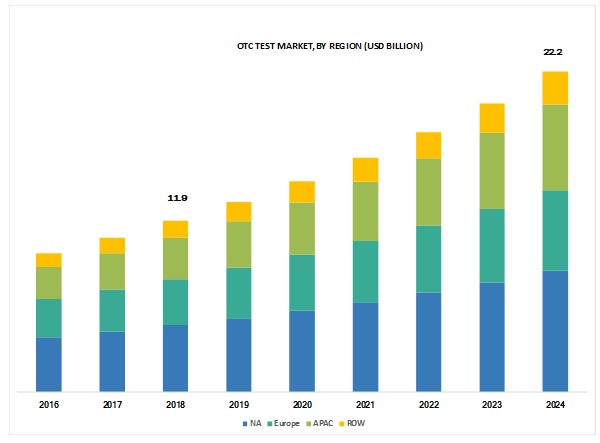
[96 Pages Report] The OTC tests market is projected to reach USD 22.2 billion by 2024 from USD 11.9 billion in 2018, at CAGR of 11.0% during the forecast period.
The growth of the OTC tests market is mainly driven by the rising prevalence of target diseases and disorders, such as diabetes and infectious diseases, both prominent ailments across the globe that require rapid and effective testing.
Download a PDF Brochure @ https://www.marketsandmarkets.com/pdfdownloadNew.asp?id=78819178
By product type, infectious disease tests are expected to be the fastest-growing segment in the OTC Test market during the forecast period.
The infectious disease tests segment is projected to grow at the highest CAGR between 2018 and 2024. Growth in this market can be attributed to factors such as the increasing number of HIV-infected individuals across the globe, coupled with increasing availability and awareness about HIV OTC testing in emerging markets such as India, Brazil, and China.
By technology, the lateral flow assays segment is growing at the highest rate.
The lateral flow assays segment is projected to grow at the highest rate in the OTC Test Market, by technology. In the past few years, the lateral flow assay POC testing market has grown significantly due to the increasing adoption of LFA testing products in home care. Companies are increasingly focusing on the development of innovative LFA-based OTC devices for the confirmation of pregnancy (using hCG levels) and ovulation, screening for infectious diseases and drugs of abuse are the factors expected to drive the growth of these markets during the forecast period
Request a Sample Pages @ https://www.marketsandmarkets.com/requestsampleNew.asp?id=78819178
The Over the Counter Test Market in the Asia Pacific is growing at the highest CAGR during the forecast period.
The Asia Pacific is estimated to grow at the highest CAGR during the forecast period. The high growth in this regional segment is majorly attributed to the increasing patient population base and the growing prevalence of infectious diseases.
Key Over The Counter Test Market Players:
The key players operating in the global Over The Counter Test Market are OraSure Technologies (US), Roche Diagnostics (Switzerland), and i-Health Lab (US). A majority of the leading players in the market focus on both organic and inorganic growth strategies such as collaborations, partnerships, acquisitions, and agreements to maintain and enhance their market shares in the OTC tests market.
To speak to our analyst for a discussion on the above findings, click Speak to Analyst
CRISPR Technology Market: Off-Target Activity and the Presence of Alternative Technologies

The research study involves four major activities in estimating the current market size for CRISPR technology. Exhaustive secondary research was conducted to collect information on the market as well as its peer and parent markets. The next step was to validate these findings, assumptions, and sizing with industry experts across the value chain through primary research. Both the top-down and bottom-up approaches were employed to estimate the complete market size. Thereafter, market breakdown and data triangulation were used to estimate the market size of segments and subsegments.
Download a PDF Brochure @ https://www.marketsandmarkets.com/pdfdownloadNew.asp?id=134401204
Major Market Growth Drivers:
The rise in the availability of government and private funding and the adoption of CRISPR technology are the key factors driving the growth of CRISPR Services Market.
Revenue Growth Analysis:
[163Pages Report] The CRISPR technology market is expected to grow from USD 562 million in 2018 to USD 1,715 million by 2023, at a CAGR of 25% during the forecast period.
Browse and in-depth TOC on "CRISPR Technology Market "
132 – Tables
24 – Figures
163 – Pages
By product and service, the CRISPR services segment is expected to be the fastest-growing in the CRISPR technology market during the forecast period.
The services segment forms the fastest-growing segment in the market, by product and service. Based on service, the CRISPR services market is segmented into gRNA design and vector construction, cell line engineering, screening services, and other CRISPR services (mediated transcriptome editing and epigenome editing services). The cell line engineering services segment is expected to grow at the highest rate.
Request a Sample Pages @ https://www.marketsandmarkets.com/requestsampleNew.asp?id=134401204
By application, the biomedical applications segment accounted for the largest share during the forecast period.
The major biomedical applications of CRISPR include gene therapy, drug discovery, and diagnostics. Across the globe, various gene therapy clinical trials are currently underway. These factors are expected to drive the adoption of CRISPR technology in this segment. In drug discovery applications, CRISPR is used to develop more physiologically relevant models (cell lines and animal models) that correlate better to the clinical setting and thereby reduce drug candidate failure in the initial steps. The ability to modify endogenous genes can help to study the effect of drugs on targets along with endogenous proteins, rather than having to rely on overexpression.
North America is expected to account for the largest CRISPR Products Market share during the forecast period.
North America is estimated to account for the largest share of the CRISPR Products Market in 2018. This is majorly attributed to the rising government and private funding, presence of major pharma and gene therapy companies, and the adoption of CRISPR in several applications. Furthermore, crops that are treated with CRISPR-based gene editing are not considered as GMOs in US; this has attracted a number of agricultural companies to focus on the commercialization of CRISPR-edited crops.
To speak to our analyst for a discussion on the above findings, click Speak to Analyst
Key CRISPR Services Market Players:
The key players operating in the global CRISPR Services Market are Cellecta, Inc. (US), Thermo Fisher (US), GeneCopoeia, Inc. (US), Applied StemCell (US), Synthego Corporation (US), OriGene Technologies (US), Horizon Discovery (UK), Merck (Germany), and GenScript (US).
Real World Evidence Solutions Market: Shift from Volume- to Value-Based Care
The growth of this market is majorly driven by the rising geriatric population (and the subsequent increase in the prevalence of chronic diseases), shift from volume- to value-based care, and delays in drug development (and the subsequent increase in development costs). The base year considered for the study is 2017 and the forecast period includes 2018 to 2023.
[157 Pages Report] The global real-world evidence market is projected to reach USD 1,348.1 million by 2023, at a CAGR of 14.3%
By therapeutic area, the oncology segment held the largest market share of the real world evidence market in 2017.
Based on therapeutic area, the oncology segment accounted for the largest share of the real-world evidence market in 2017. The large share of this segment can be attributed to the high number of clinical trials conducted for oncology and the rising prevalence of cancer worldwide.
Download a PDF Brochure @ https://www.marketsandmarkets.com/pdfdownloadNew.asp?id=76173991
By end user, the pharmaceutical & medical device companies segment held the largest market share of the real world evidence market in 2017.
Based on end user, the pharmaceutical & medical device companies segment accounted for the largest share of the real world evidence market. The large share of this segment can be attributed to the increasing importance of RWE studies in drug approvals, the need to prevent costly drug recalls, and the increasing need to assess drug performance in real-world settings.
Request a Sample Pages @ https://www.marketsandmarkets.com/requestsampleNew.asp?id=76173991
North America dominated the market in 2017.
North America accounted for the largest share of the real world evidence market in 2017, followed by Europe and Asia Pacific. Presence of a favorable regulatory environment, high number of RWE service providers, the presence of a well-established pharmaceutical industry in the region, coupled with the high R&D expenditure, are the major factors responsible for the large share of North America in the global real world evidence market.
Key Market Players:
IQVIA (US), ICON (Ireland), PAREXEL (US), Pharmaceutical Product Development (US), and Optum (US) held the major share of the real world evidence market and will continue to dominate the market between 2018 and 2023. Other major players operating in this market include International Business Machines Corporation (US), Cognizant (US), Oracle (US), SAS (US), Syneos Health (US), Anthem (US), Clinigen Group (UK), Palantir Technologies (UK), and Flatiron Health (US).
To speak to our analyst for a discussion on the above findings, click Speak to Analyst
Veterinary Software Market: Shortage of Veterinary Practitioners in Developing Countries
The veterinary software market to grow from USD 442 million in 2017 to USD 594 million by 2022, at a CAGR of 6.1% during the forecast period
The major factors that are expected to be driving the veterinary software market are rising companion animal ownership and demand for pet insurance with growing animal health expenditure. However, lack of government incentives for the adoption of veterinary software, reluctance of veterinarians towards adopting new technologies, and lack of awareness about veterinary software in the developing countries are restricting the growth of Veterinary Software Industry.
Download a PDF Brochure @ https://www.marketsandmarkets.com/pdfdownloadNew.asp?id=186264514
By delivery model, the on-premise delivery model segment is expected to dominate the veterinary software market.
On the basis of delivery model, the global veterinary software market is segmented into two broad categories—on-premise model, and web-based/cloud-based model. The on-premise model segment is estimated to account for the largest share of the global veterinary software market in 2017. The large share of this segment can be attributed to the advantages of the on-premise delivery model, such as the low risk of data breach, flexible connection bandwidth, and the availability of easy customization options.
Request a Sample Pages @ https://www.marketsandmarkets.com/requestsampleNew.asp?id=186264514
By practice type, the exclusive small animal practices segment is expected to register the highest CAGR during the forecast period.
On the basis of practice type, the veterinary software market is segmented into exclusive small animal practices, mixed animal practice, and exclusive large animal practices. The exclusive small animal practices segment is expected to register the highest CAGR during the forecast period. The high growth in this segment can be attributed to the increasing number of small pet owners and rising annual spending on pet care in developed countries.
The North America Veterinary Software Industry is expected to grow at the highest CAGR during the forecast period
North America is expected to witness the highest growth from 2017 to 2022, owing to the growing demand for quality pet care. This, in turn, is encouraging veterinarian practices to adopt technology solutions such as digital imaging systems and veterinary practice management software for better diagnosis. Other growth factors include growing awareness about veterinary software and the easy availability of veterinary software and services in this region.
To speak to our analyst for a discussion on the above findings, click Speak to Analyst
Key Market Players:
Henry Schein (US), IDEXX Laboratories (US), Patterson Companies (US), Vetter Software (US), Animal Intelligence Software (US), Timeless Veterinary Systems (Canada), Brittons Wise Computers (US), ezyVet Limited (New Zealand), FirmCloud Corporation (US), MedaNext (US), OR Technology (Oehm Und Rehbein GmbH, Germany), VIA Information Systems (US), Hippo Manager Software (US), Finnish Net Solutions (Finland), Carestream (Canada), and ClienTrax (US)
OTC Braces and Supports Market: Rising Number of Sports and Accident-Related Injuries
The supportive government regulations for product commercialization, high prevalence of musculoskeletal conditions in the adult population, continuous development and commercialization of novel OTC orthopedic braces & support products, significant number of sports-related injuries in the country, active public participation in physical activities, and the presence of major manufacturers are driving the growth of the OTC braces and supports market.
How much is the OTC Orthopedic Braces Market worth?
The OTC Orthopedic Braces market is projected to reach USD 1.5 billion by 2024 from USD 1.2 billion in 2019, at a CAGR of 5.1%. Growth in the market is primarily driven by the growing public awareness related to preventive care, increasing prevalence of orthopedic diseases & disorders, and the rising number of sports and accident-related injuries. North America is expected to register the highest growth rate during the forecast period mainly due to continuous development and commercialization of novel orthopedic braces.
Download PDF Brochure @
https://www.marketsandmarkets.com/pdfdownloadNew.asp?id=113271585
Knee braces and supports segment accounted for the largest share of the OTC braces and supports market, by product, in 2018
The knee braces and supports segment accounted for the largest share of the orthotic braces market, by product, in 2018. The large share of this segment can be attributed to the growing geriatric & obese population as they are at a higher risk of developing osteoarthritis and other knee-related conditions, increasing incidence of sports injuries, and the benefits offered by these products, such as medial and lateral support, reduced rotation of the knee, limited injury during motion, and protection from the post-surgical risk of injury.
Soft & elastic braces and supports segment to register the highest growth in the orthotic braces market, by type, during the forecast period
The soft & elastic braces and supports segment is expected to grow at the highest CAGR during the forecast period. Growth in this market can primarily be attributed to the growing availability of advanced products, increasing adoption & patient preference for orthopedic braces in post-operative & preventive care, the rising number of road accidents, and the increasing incidence of sports injuries.
Preventive care segment accounted for the largest share of the OTC orthopedic braces market, by application, in 2018
Preventive care is the largest application segment of the OTC orthopedic braces market, and this trend is expected to continue during the forecast period. The large share of this segment can primarily be attributed to the growing public participation in sports and the increasing availability of OTC bracing products for preventive care & ambulatory procedures.
Request for Sample Pages @ https://www.marketsandmarkets.com/pdfdownloadNew.asp?id=113271585
North America is the largest regional market for OTC braces and supports
This report covers the market across five major geographies, namely, North America, Europe, the Asia Pacific, Latin America, and the Middle East and Africa. Of the five geographic regions studied in the report, North America is expected to register the highest growth rate during the forecast period mainly due to continuous development and commercialization of novel orthopedic braces.
Geographically, the orthotic braces market is segmented into North America, Europe, the Asia Pacific, Latin America, and the Middle East and Africa. North America accounted for the largest share of the market in 2019. Factors such as continuous development and commercialization of novel orthopedic braces & support products, growing awareness about the effective use of prophylactic braces among people participating in sports, and the greater adoption of prophylactic braces during other physical activities (such as dancing) are driving the market for OTC braces and supports in North America.
Leading Companies
The major players in the market include Bauerfeind AG (Germany), Össur Hf (Iceland), DJO Finance LLC (US), Breg, Inc. (US), and DeRoyal Industries, Inc. (US). Other prominent players operating in this market include Bird & Cronin, Inc. (US), medi GmbH & Co. KG (Germany), Ottobock Holding GmbH & Co. KG (Germany), BSN medical (Germany), Zimmer Biomet Holdings, Inc. (US), Oppo Medical, LLC (US), Becker Orthopedic (US), Thuasne Group (France), 3M Company (US), Reh4Mat (Poland), and United Ortho (US).
For more information @ https://www.marketsandmarkets.com/PressReleases/otc-orthopedic-braces.asp
Patient Safety and Risk Management Software Market: Increasing Use of Big Data Analytics for Patient Safety
Increasing patient population in this region, rapid return on investment (ROI), and rising government initiatives to improve the patient safety & patient outcomes in healthcare. On the other hand, the dearth of in-house IT expertise and the reluctance of healthcare providers to adopt new methods of patient safety and risk management are expected to restrain the growth of the market to a certain extent during the forecast period.

How much is the Patient Safety and Risk Management Software Market worth?
The Patient Safety and Risk Management Software market to reach USD 2.2 billion by 2024 from USD 1.3 billion in 2019, growing at a CAGR of 11.2% during the forecast period. The rising need to curtail healthcare costs, increasing incidences of medical errors & hospital-acquired infections, and growing government initiatives to improve patient safety and patient outcomes are key drivers of this market. North America accounted for the largest share of this market majorly due to the favorable regulations (such as Patient Safety Act and Patient Protection and Affordable Care Act) combined with the high healthcare IT spending in the region, and greater adoption.
The market for governance, risk & compliance solutions is projected to grow at the highest CAGR during the forecast period
Based on type, the market for governance, risk, & compliance (GRC) solutions is expected to grow at the highest rate during the forecast period. The high growth of this segment is attributed to the increasing number of adverse events to patients across the globe and the effective utilization of GRC solutions. GRC solutions provide safe, high-quality care to patients while maintaining compliance with industry standards and regulations.
The market for ambulatory care centers is expected to witness the highest growth during the forecast period
The market for ambulatory care centers is projected to grow at the highest rate during the forecast period. The high growth rate of this segment can be attributed to the rising need to minimize the risk associated with patient harm. In addition, implementation of patient safety and risk management software is vital for ambulatory care centers as it helps them in the effective management of patient safety events.
Download PDF Brochure @
https://www.marketsandmarkets.com/pdfdownloadNew.asp?id=231628922
By end-user, the healthcare payers segment is expected to grow at the highest CAGR during the forecast period.
Based on end-user, the patient safety and risk management solutions market has been segmented into hospitals, long-term care centers, ambulatory care centers, pharmacies, and other end-users (primary care providers, ambulance services, pathology laboratories, and mental healthcare centers. The ambulatory care centers segment is expected to grow at the highest CAGR during the forecast period.
North America to account for the largest market size during the forecast period.
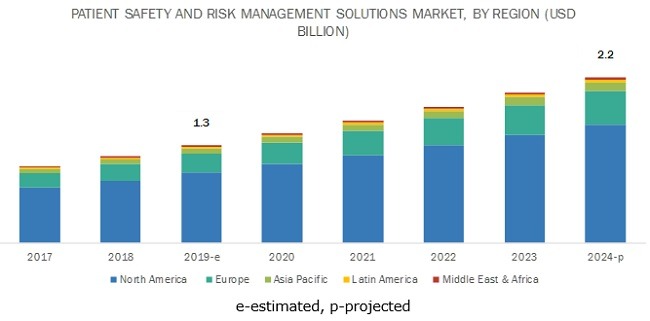
This report covers the market across four major geographies, namely, North America, Europe, Asia-Pacific, and the Rest of the World (RoW). Of the four geographic regions studied in the report, Asia-Pacific is expected to register the highest growth rate during the forecast period mainly due to the favorable regulations (such as Patient Safety Act and Patient Protection and Affordable Care Act) combined with the high healthcare IT spending in the region, and greater adoption.
Geographically, the patient safety and risk management market is segmented into North America, Europe, Asia-Pacific, and the Rest of the World. North America is expected to account for the largest share of the patient safety and risk management software market in 2019, followed by Europe. Several healthcare organizations in Asia are actively moving towards digitization to streamline their entire workflow and ensure patient care and safety that resulted in an increased demand for patient safety and risk management software to ensure better patient care.
Leading Companies
The major players in the market include RLDatix (Canada), Verge Health (US), Riskonnect Inc. (US), Clarity Group Inc. (US), RiskQual Technologies (US), The Patient Safety Company (Netherlands), Quantros Inc. (US), Prista Corporation (US), Smartgate Solutions Ltd. (UK), and Conduent Inc. (US).
For more information @ https://www.marketsandmarkets.com/PressReleases/patient-safety-risk-management-software.as
Cleanroom Technology Market: Increasing Demand for Cleanrooms in Developing Economies
The stringent regulatory framework, growth of the biologics sector, rising demand for sterilized pharmaceutical formulations, growing demand for medical devices, and technological advancements in cleanroom technology are major factors driving the growth of Cleanroom Technologies Market
How much is the healthcare Cleanroom Market worth? 
The cleanroom technologies market is projected to reach USD 7.9 billion by 2024 from USD 5.7 billion in 2019, at a CAGR of 6.6% during the forecast period. Factors such as the increasing healthcare expenditure and growing base of pharma companies in the country are some of the key factors driving the growth of the cleanroom technologies market. The global cleanroom technology market is segmented into four major regions, namely, North America, Europe, the Asia Pacific, and the Rest of the World. Asia-pacific accounted for the largest share of this market majorly due to its favorable government regulations, increasing healthcare expenditure, and the growing base of pharma companies in the country, all of which are driving adoption of cleanroom solutions in the Asia Pacific.
Download PDF Brochure @
https://www.marketsandmarkets.com/pdfdownloadNew.asp?id=263122482
By product, the consumables segment is expected to account for the largest share of the cleanroom technology market
The consumables segment is estimated to account for the largest market share in 2018. The large share of this segment can be attributed to the high and growing number of pharmaceutical, biotech, and medical device companies facilitating the use of disposable protective clothing. Also, the large number of R&D activities in the healthcare industry is resulting in a stable demand for cleanroom consumables among end-users. This segment includes safety consumables and cleaning consumables.
In the cleanroom construction market, by type, the hardwall cleanrooms segment is expected to grow at the highest CAGR during the forecast period
The hardwall cleanrooms segment is expected to grow at the highest CAGR during the forecast period. The growth in this segment can be attributed to factors such as the higher demand for hardwall cleanrooms, as they are more design-flexible than standard and softwall cleanrooms, quick and easy to install, freestanding for easy portability, and easy to expand or reconfigure.
Based on the end-user, the pharmaceutical industry segment is expected to account for the largest share of the cleanroom technologies market
The pharmaceutical industry end-user segment is estimated to account for the largest market share in 2018. The large share of this segment can be attributed to the industrial growth in this sector, the robust pipeline of injectable formulations, and rising focus on ensuring the quality of healthcare products.
Request for Sample Pages @
https://www.marketsandmarkets.com/requestsampleNew.asp?id=263122482
Asia Pacific is estimated to be the fastest-growing market for cleanroom technologies during the forecast period
The APAC market is projected to register the highest growth during the forecast period. Factors such as the increasing healthcare expenditure and growing base of pharma companies in the country are some of the key factors driving the growth of the healthcare Cleanroom market in the APAC. 
Which are the key players in the healthcare Cleanroom Market and how intense is the competition?
Azbil Corporation (Japan), Kimberly-Clark Corporation (US), Ardmac (Ireland), Clean Air Products (US), Labconco Corporation (US), Dynarex Corporation (US), DowDuPont Inc. (US), Illinois Tool Works Inc. (US), Taikisha Ltd. (Japan), Exyte AG (Germany), COLANDIS GmbH (Germany), ABN Cleanroom Technology (Belgium), Clean Rooms International, Inc. (US), Bouygues Group (France), Terra Universal, Inc. (US), Connect 2 Cleanrooms Ltd (UK), Camfil (Sweden), OCTANORM-Vertriebs-GmbH (Germany), Parteco Srl (Italy), and Airtech Japan, Ltd. (Japan).
Kimberly-Clark has an extensive range of cleanroom consumables and a prominent presence across the globe. It targets faster-growing as well as higher-margin segments such as wiping & safety consumables within the K-C Professional business segment to achieve further growth. In 2018, the company unified its core categories of personal protective equipment, including apparel, gloves, and eyewear, under a revitalized KleenGuard brand with an aim to increase productivity and enhance worker performance. Kimberly-Clark also focuses on increasing investments in R&D to develop new innovative products. For instance, the company spent around USD 3.3 billion in 2018 as compared to the USD 3.2 billion spent on R&D in 2017.
- In July 2019, Azbil Corporation launched its Biological Safety Cabinets, BiOptima.
- In June 2019, Exyte Group opened a new manufacturing facility in Renningen, Germany.
- In May 2018, Kimberly-Clark Corporation invested USD 30 million for the expansion of its nonwovens manufacturing facility in Hendersonville, North Carolina.
- In February 2019, Kimberly-Clark Corporation opened a global digital technology center in Bengaluru, India.
Speak to analyst @ https://www.marketsandmarkets.com/speaktoanalystNew.asp?id=263122482
Patient Safety and Risk Management Software Market: Use of Artificial Intelligence and Predictive Analytics for Patient Safety
The rising need to curtail healthcare costs, increasing incidences of medical errors & hospital-acquired infections, and growing government initiatives to improve patient safety and patient outcomes are key drivers of this market. On the other hand, the dearth of in-house IT expertise and the reluctance of healthcare providers to adopt new methods of patient safety and risk management are expected to restrain the growth of the market to a certain extent during the forecast period.
How much is the Patient Safety and Risk Management Software Market worth?
MarketsandMarkets forecasts the Patient Safety and Risk Management Software market to grow from USD 2.2 billion by 2024 from a value of USD 1.3 billion in 2019, growing at a CAGR of 11.2 during the forecast period. Increasing patient population in this region, rapid return on investment (ROI), and rising government initiatives to improve the patient safety & patient outcomes in healthcare. The global Patient Safety and Risk Management Software market is segmented into four major regions, namely, North America, Europe, the Asia Pacific, and the Rest of the World. In 2019, North America accounted for the largest share of this market majorly due to the favorable regulations (such as Patient Safety Act and Patient Protection and Affordable Care Act) combined with the high healthcare IT spending in the region, and greater adoption.
The market for governance, risk & compliance solutions is projected to grow at the highest CAGR during the forecast period
Based on type, the market for governance, risk, & compliance (GRC) solutions is expected to grow at the highest rate during the forecast period. The high growth of this segment is attributed to the increasing number of adverse events to patients across the globe and the effective utilization of GRC solutions. GRC solutions provide safe, high-quality care to patients while maintaining compliance with industry standards and regulations.
Download PDF Brochure @
https://www.marketsandmarkets.com/pdfdownloadNew.asp?id=231628922
The market for ambulatory care centers is expected to witness the highest growth during the forecast period
The market for ambulatory care centers is projected to grow at the highest rate during the forecast period. The high growth rate of this segment can be attributed to the rising need to minimize the risk associated with patient harm. In addition, implementation of patient safety and risk management software is vital for ambulatory care centers as it helps them in the effective management of patient safety events.
By end-user, the healthcare payers segment is expected to grow at the highest CAGR during the forecast period.
Based on end-user, the patient safety and risk management solutions market has been segmented into hospitals, long-term care centers, ambulatory care centers, pharmacies, and other end-users (primary care providers, ambulance services, pathology laboratories, and mental healthcare centers. The ambulatory care centers segment is expected to grow at the highest CAGR during the forecast period.
North America to account for the largest market size during the forecast period.
North America is the major revenue generating region in the Patient Safety Management Software market. Several healthcare organizations in Asia are actively moving towards digitization to streamline their entire workflow and ensure patient care and safety that resulted in an increased demand for patient safety and risk management software to ensure better patient care.
Request for Sample Pages @
https://www.marketsandmarkets.com/requestsampleNew.asp?id=231628922
Who are the leading vendors operating in Patient Safety and Risk Management Solutions Market?
RLDatix (Canada), Verge Health (US), Riskonnect Inc. (US), Clarity Group Inc. (US), RiskQual Technologies (US), The Patient Safety Company (Netherlands), Quantros Inc. (US), Prista Corporation (US), Smartgate Solutions Ltd. (UK), and Conduent Inc. (US).
RLDatix (Canada) is one of the leading players in the market and accounted for the largest share in 2018. RLDatix is one of the leading providers of cloud-based and integrated software solutions for patient safety and risk management to various industries, including healthcare. To strengthen its market position and to broaden its product offerings, the company majorly focuses on agreement, acquisitions, and mergers.
- In June 2019, Riskonnect Inc. launched Riskonnect ClearSight 19.0, an addition to its integrated risk management platform.
- In May 2019, RLDatix entered into an agreement to acquire iContracts (US) that provided more significant opportunities to RLDatix.
- In February 2019, Verge Health entered into a partnership with the Texas Hospital Association (US) to strengthen its governance, risk, & compliance platform.
- In October 2018, Riskonnect, Inc. acquired Marsh ClearSight LLC (US) to expand its product offerings.
- In August 2017, Conduent Inc. (US) launched the Midas Hospital Risk Adjustment Model.
Dental 3D Printing Market to Receive Overwhelming Hike in Revenues by 2023
In current scenario of the dental industry, there is demand for fast production of highly customized dental products. Since, the 3D printing is a well-established option for faster production of the customized parts, easy to use, highly accurate, and cost effective 3D printing solution are being increasingly preferred over the milling-based methods. The technology advancements in hardware, materials, and the software are driving the adoption of dental 3D printing & scanning equipment.
The Global Dental 3D Printing Market is projected to reach USD 5.06 billion by 2023 from an estimated USD 1.78 billion in 2018, at a CAGR of 23.2%. The key factors driving the growth of this market include high incidence of dental caries and other dental diseases, rising demand for cosmetic dentistry, adoption of dental 3D printers in hospitals and clinics, rapid growth in the geriatric population and its association with the rising prevalence of edentulism, and increasing disposable income in developing countries. North America is expected to register the highest growth rate during the forecast period mainly due to the rising incidence of dental caries and tooth loss associated with the aging population, growing Oral Care expenditure, technological advancement, increasing demand of cosmetic energy, and rising popularity of digital dentistry. Asia Pacific region is expected to grow at a higher CAGR during the forecast period.
By technology, the vat photopolymerization segment accounted for the largest share of this market in 2017
On the basis of technology, this market is segmented into vat photopolymerization, fused deposition modeling, selective laser sintering, polyjet technology, and other technologies. The vat photopolymerization segment accounted for the largest share of the global dental 3D printing market. The high precision and accuracy of this technique is primarily attributed to the large share of this segment.
Download PDF Brochure @
https://www.marketsandmarkets.com/pdfdownloadNew.asp?id=258228239
By application, the prosthodontics segment held the largest share of the dental 3D printing market in 2017
Based on application, this market is segmented into prosthodontics, endodontics, and implantology. The prosthodontics segment accounted for the largest share in this market. The large share of this segment can primarily be attributed to the growing demand for crowns and bridges, rising prevalence of dental caries, increasing incidence of tooth loss, and increasing customer acceptance of advanced dental technologies.
North America is expected to dominate the Dental 3D Printing market in 2017
This report covers the market across four major geographies, namely, North America, Europe, Asia-Pacific, and the Rest of the World (RoW). Of the four geographic regions studied in the report, North America is expected to register the highest growth rate during the forecast period mainly due to high and growing incidence of dental caries and tooth loss (associated with the aging population), high oral care expenditure, development of 3D printing technologies offering high accuracy and reduced time for printing, increasing demand for cosmetic dentistry, and rising popularity of digital dentistry.
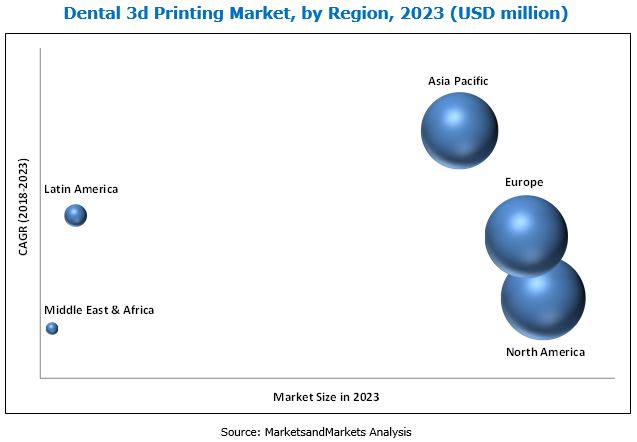
Geographically, the global dental 3D printing market is segmented into North America, Europe, Asia Pacific, Latin America, and the Middle East and Africa. North America holds the largest share of this market in 2017. Asia Pacific region is expected to grow at a higher CAGR during the forecast period.
Request for Sample Pages @
https://www.marketsandmarkets.com/requestsampleNew.asp?id=258228239
Leading Companies
The major players in the market include 3D Systems (US), Stratasys (US/Israel), Renishaw (UK), Roland DG (Japan), SLM Solutions (Germany), EnvisionTEC (Germany), DENTSPLY Sirona (US), Straumann (Switzerland), Formlabs (US), Prodways Group (France), EOS (Germany), Rapid Shape (Germany), DWS (Italy), Planmeca (Finland), Kulzer GmbH (Germany), Ultimaker (Netherlands), Dental Wings (Canada), Carbon (US), and Asiga (Australia).
Growth of Tissue Diagnostics Market due to Rising Incidence in Cancer along with a Rapidly Aging Population
The increasing pressure to identify diagnostic markers for cancer in order to customize treatment plans for individual patients is expected to increase the usage of personalized medicine for cancer. Tissue diagnostics enables the identification of these cancer markers, and several tissue diagnostics kits are being investigated as companion diagnostics for cancer therapies. Thus, the growing use of personalized medicine is expected to support the growth of the tissue diagnostics market.
The growing incidence of cancer along with a rapidly aging population, technological advancements in tissue diagnostics techniques, and increasing healthcare expenditure are key factors driving the growth of the tissue diagnostics market.
How much is the Tissue Diagnostics Market worth?
The tissue diagnostics market is expected to reach USD 5.14 Billion by 2022 from USD 3.44 Billion in 2016 at a CAGR of 6.9% during the forecast period. North America was the largest market for tissue diagnostics in 2017, due to several factors such as the strong presence of market players in the region, the growing geriatric population and chronic disease incidence, and easy access to healthcare services. However, Asia is expected to witness the highest CAGR during the forecast period with growth centered at Japan, China, and India.
Download PDF Brochure @
https://www.marketsandmarkets.com/pdfdownloadNew.asp?id=1063949
By product, the market is segmented into instruments and consumables. The consumables segment is estimated to account for the largest market share of the global market in 2017. Factors driving the growth of this segment include the widespread use of consumables and advances in technology to develop novel consumables.
By technology, the market is classified into immunohistochemistry, in situ hybridization, digital pathology and workflow, and special staining. The immunohistochemistry segment is estimated to account for the largest share of the global market during the next five years. Growth in the IVD (in vitro diagnostics) market and the large number of products based on this technology are driving the growth of this market.
Request for Sample Pages @
https://www.marketsandmarkets.com/requestsampleNew.asp?id=1063949
On the basis of end user, the tissue diagnostics market is segmented into hospitals, pharmaceutical companies, research laboratories, contract research organizations, and other end users. The hospitals segment is estimated to account for the largest share of the global tissue diagnostics market during the forecast period. Growth in the number of hospitals coupled with better accessibility and availability of test results in hospitals are major factors driving the growth of this end-user segment.
Which are the key players in the Tissue Diagnostics market and how intense is the competition?
Roche (Switzerland), Danaher (US), Thermo Fisher Scientific (US), Abbott (US), Agilent Technologies (US), Merck (Germany), Sakura Finetek Japan (Japan), Abcam (UK), BD (US), QIAGEN (Netherlands), Sienna Cancer Diagnostics (Australia), Royal Philips (Netherlands), A. Menarini Diagnostics (Italy), Cell Signaling Technology (US), Enzo Life Sciences (US), Master Diagnóstica (Spain), TissueGnostics (Austria), Bio SB (US), MedImmune (US), Cernostics (US), Zenalux Biomedical (US), 3DHISTECH (Hungary), Lunaphore Technologies (Switzerland), BioGenex (US), and Biocare Medical (US).
- In 2015, the company introduced VENTANA HE 600 system, which is a new automated hematoxylin and eosin (H&E) tissue staining system with customizable protocols.
- In 2017, the company partnered with Advanced Cell Diagnostics (US) to develop and commercialize innovative tissue diagnostic instruments.
Healthcare Asset Management Market to Receive Overwhelming Hike in Revenues by 2023
<!-- wp:paragraph -->
Growing pressure to better manage their existing workforce has compelled healthcare organizations across the globe to adopt effective asset management solutions and technologies. Most healthcare organizations spend a large portion of their budget on tracking hospital equipment. For example, it was reported that ~USD 6 million worth of state-owned hospital equipment was found to be missing in Louisiana State University (LSU) hospitals; newly purchased equipment from the hospital were also not properly tracked. Thus, wastage of time in searching for lost assets and poor asset management practices can lead to serious consequences. According to a recent survey conducted by the Nursing Times, more than one-third of nurses spend at least an hour locating equipment during an average hospital shift. This not only impacts budgets but also compromises the quality of patient care provided.
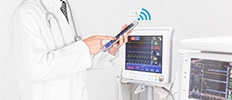 |
How much is the Healthcare Asset Management Market worth?
The global Healthcare Asset Management market is projected to reach USD 35.19 billion by 2023 from USD 8.98 billion from 2018, at a CAGR of 31.4%. Need for better asset management in hospitals, acceptance of asset management solutions in pharmaceutical industry, and decline in prices of RFID Tags are the factors driving the growth of the healthcare asset management market. North America is expected to register the highest growth rate during the forecast period mainly due to growing patient safety concerns, acceptance of healthcare asset management solutions in hospitals, increasing need to tackle drug counterfeiting, technologically advanced products, and the presence of key players in the region.
Based on type, the healthcare asset management market is segmented into tags, readers/interrogators, antennas, and accessories. In 2018, the RFID tags segment is expected to dominate the market. The growth of this market is attributed to the increasing acceptance of RFID in pharmaceutical companies, declining prices of RFID tags, and the availability of technologically advanced products in the market.
Download PDF Brochure @
https://www.marketsandmarkets.com/pdfdownloadNew.asp?id=1195
Based on type, the passive RFID tag segment is projected to grow at the highest CAGR during the forecast period.
Based on type, RFID tags market is segmented into passive tags and active tags. In 2018, the passive RFID segment is expected to account for the largest share of the market; also, this segment is expected to register highest CAGR during the forecast period owing to the low cost of passive tags in comparison with active tags. Also, passive tags do not require an external source of energy, owing to which they are more widely adopted. Hospitals segment is estimated hold the largest share of the market in 2017.
North America is expected to dominate the Healthcare Asset Management market in 2018
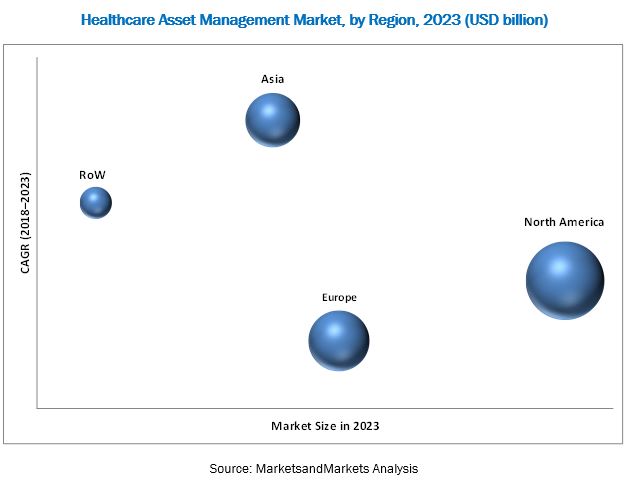
This report covers the market across four major geographies, namely, North America, Europe, Asia-Pacific, and the Rest of the World (RoW). Of the four geographic regions studied in the report, North America is expected to register the highest growth rate during the forecast period mainly due to growing patient safety concerns, acceptance of healthcare asset management solutions in hospitals, increasing need to tackle drug counterfeiting, technologically advanced products, and the presence of key players in the region.
Geographically, the Healthcare Asset Management market is segmented into North America, Europe, Asia-Pacific, and the Rest of the World. North America accounted for the largest share of the market in 2018, followed Europe. The dominance of the North American market is attributed to factors such as growing patient safety concerns, acceptance of healthcare asset management solutions in hospitals, increasing need to tackle drug counterfeiting, technologically advanced products, and the presence of key players in the region.
Request for Sample Pages @
https://www.marketsandmarkets.com/requestsampleNew.asp?id=1195
Leading Companies
The major players in the market include AiRISTA Flow (US), Elpas (US), CenTrak, Inc. (US), ThingMagic [A Novanta Company (US], Sonitor (Norway), Stanley Healthcare (US), Versus Technology, Inc. (US), Zebra Technologies (US), GE Healthcare (US), and IBM Corporation (US).
<!-- /wp:paragraph -->
Healthcare Fraud Analytics Market worth USD 4.6 billion by 2025, at a CAGR of 29.8%
The report "Healthcare Fraud Analytics Market by Solution Type (Descriptive, Predictive, Prescriptive), Application (Insurance Claim (Postpayment, Prepayment), Payment Integrity), Delivery (On-premise, Cloud), End User (Insurance, Government) - Global Forecast to 2025", is projected to reach USD 4.6 billion by 2025 from USD 1.2 billion in 2020, at a CAGR of 29.8% during the forecast period. The growth of this market is mainly due to a rise in the number of fraudulent activities in healthcare, combined with the increasing number of patients seeking medical insurance and rising pharmacy claim-related frauds. Emerging markets like APAC and Latin America provide significant growth opportunities in this market.
Browse 105 market data Tables and 32 Figures spread through 144 Pages and in-depth TOC on "Healthcare Fraud Analytics Market by Solution Type (Descriptive, Predictive, Prescriptive), Application (Insurance Claim (Postpayment, Prepayment), Payment Integrity), Delivery (On-premise, Cloud), End User (Insurance, Government) - Global Forecast to 2025"
Speak to Analyst @ https://www.marketsandmarkets.com/speaktoanalystNew.asp?id=221837663
The prescriptive analytics segment registered the highest growth during the forecast period.
Fraud analytics solutions vary from vendor to vendor. Some vendors offer rule-based models while others offer AI-based technologies, but broadly, these solutions are classified based on the type of analytics used—descriptive analytics, predictive analytics, and prescriptive analytics. The prescriptive analytics segment registered the highest growth in the healthcare fraud analytics market during the forecast period. The high adoption of this technology is attributed to its advantages, such as rapid detection and investigation of suspects, claimants, and claim-level behavior from unstructured and/or semi-structured data.
In 2019, public & government agencies accounted for the largest share of the healthcare fraud analytics market, by end user.
Based on end user, the healthcare fraud detection market is segmented into public & government agencies, private insurance payers, employers, and third-party service providers. The public & government agencies segment accounted for the largest share of the healthcare fraud analytics market in 2019. The increasing cost burden due to healthcare fraud is proving to be a financial threat to public and government agencies globally. These factors are compelling payer organizations associated with these agencies to adopt analytics solutions to avoid losses incurred due to FWA and improper payments, which is driving the market growth.
Download a PDF Brochure @ https://www.marketsandmarkets.com/requestsampleNew.asp?id=221837663
North America dominated the market in 2019
North America accounted for the largest share of the healthcare fraud analytics market in 2019, followed by Europe. Factors such as the high number of cases of healthcare fraud, including pharmacy-related fraud, favorable government initiatives, technological advancements, and the availability of solutions in this region are some factors contributing to North America’s large share in the global healthcare fraud analytics space.
Request Sample Pages @ https://www.marketsandmarkets.com/requestsampleNew.asp?id=221837663
Cleanroom Technologies Market: Global Industry Analysis and Forecast 2019–2024
According to the new market research report “Cleanroom Technologies Market by Product (HVAC, HEPA filters, air shower, apparel, gloves, vacuum systems, disinfectants), Construction (Drywall, Hardwall, Softwall), End User (Pharmaceutical, Biotechnology, Hospitals) - Global Forecast to 2024”, published by MarketsandMarkets™, the Cleanroom Technology Market is projected to reach USD 7.9 billion by 2024 from USD 5.7 billion in 2019, growing at a CAGR of 6.6% between 2019 and 2024.
Don’t miss out on business opportunities in Cleanroom Technology Market.
The major factors driving the growth of this market are the stringent regulatory framework, growth of the biologics sector, rising demand for sterilized pharmaceutical formulations, growing demand for medical devices, and technological advancements in cleanroom technology.
By product, the consumables segment is expected to account for the largest share of the cleanroom technologies market
The consumables segment is estimated to account for the largest market share in 2018. The large share of this segment can be attributed to the high and growing number of pharmaceutical, biotech, and medical device companies facilitating the use of disposable protective clothing. Also, the large number of R&D activities in the healthcare industry is resulting in a stable demand for cleanroom consumables among end-users. This segment includes safety consumables and cleaning consumables.
Browse in-depth TOC on “Cleanroom Technology Market”
212 — Tables
30 — Figures
214 — Pages
Download PDF Brochures — https://www.marketsandmarkets.com/pdfdownloadNew.asp?id=263122482
In the cleanroom construction market, by type, the hardwall cleanrooms segment is expected to grow at the highest CAGR during the forecast period
The hardwall cleanrooms segment is expected to grow at the highest CAGR during the forecast period. The growth in this segment can be attributed to factors such as the higher demand for hardwall cleanrooms, as they are more design-flexible than standard and softwall cleanrooms, quick and easy to install, freestanding for easy portability, and easy to expand or reconfigure.
Asia Pacific is estimated to be the fastest-growing market for cleanroom technologies during the forecast period
The APAC market is projected to register the highest growth during the forecast period. Factors such as the increasing healthcare expenditure and growing base of pharma companies in the country are some of the key factors driving the growth of the cleanroom technologies market in the APAC.
Inquiry Before Buying: https://www.marketsandmarkets.com/Enquiry_Before_BuyingNew.asp?id=263122482
Key Players
Azbil Corporation (Japan), Kimberly-Clark Corporation (US), Ardmac (Ireland), Clean Air Products (US), Labconco Corporation (US), Dynarex Corporation (US), DowDuPont Inc. (US), Illinois Tool Works Inc. (US), Taikisha Ltd. (Japan), Exyte AG (Germany), COLANDIS GmbH (Germany), ABN Cleanroom Technology (Belgium), Clean Rooms International, Inc. (US), Bouygues Group (France), Terra Universal, Inc. (US), Connect 2 Cleanrooms Ltd (UK), Camfil (Sweden), OCTANORM-Vertriebs-GmbH (Germany), Parteco Srl (Italy), and Airtech Japan, Ltd. (Japan).
Worldwide Cellular Health Testing Market Analysis and Forecast Report till 2022
The report "Cellular Health Testing Market by Type (Single (Telomere, Oxidative Stress, Inflammation, Heavy Metal), Multitest), Sample (Blood, Saliva, Serum, Urine), Collection Site (Home, Office, Hospital, Diagnostic Labs), and Region - Global Forecast to 2022", The global cellular health screening market is expected to reach USD 3.42 Billion by 2022 from USD 2.12 Billion in 2017, at a CAGR of 10.0% during the forecast period.
Don’t miss out on business opportunities in Cellular Health Testing Market.
Speak to our analyst and gain crucial industry insights that will help your business grow: https://www.marketsandmarkets.com/speaktoanalystNew.asp?id=227041930
“Single test panels to dominate the market in 2017”
Based on type, the global cellular health screening market is segmented into single test panels and multi-test panels. In 2017, the single test panels segment is expected to account for the largest share of the global cellular health screening market. These panels are used to get accurate information about a single biomarker and understand how it affects the health of an individual. The preference for multi-test panels is increasing in the market as they provide results for multiple biomarkers in a single exam.
“Based on sample collection site, the at-home segment is projected to grow at the highest CAGR”
By sample collection site, the global cellular health screening market is segmented into at-home, in-office, and other sample collection sites. The at-home segment is expected to register the highest CAGR during the forecast period. The availability of diagnostic and therapeutic products that can be used by patients at home without assistance from healthcare professionals are expected to boost the demand for cellular health screening in this segment.
Download an Illustrative overview of the report @ https://www.marketsandmarkets.com/pdfdownloadNew.asp?id=227041930
Key Players
Genova Diagnostics (U.S.), Telomere Diagnostics (U.S.), Life Length (Spain), Quest Diagnostics (U.S.), Repeat Diagnostics (Canada), SpectraCell Laboratories (U.S.), Zimetry LLC (U.S.), Cell Science Systems (U.S.), Titanovo, Inc. (U.S.), Segterra, Inc. (U.S.), LabCorp Holdings (U.S.), BioReference Laboratories (U.S.), Immundiagnostik AG (Germany), DNA Labs (India), and Cleveland HeartLab, Inc. (U.S.)
In 2016, Telomere Diagnostics accounted for the largest share of the cellular health screening market. With its large presence and expertise in telomere testing, the company has maintained its leadership position in the market. Telomere majorly focuses on developing new products that offer innovative solutions to help people test their cellular health and take preventive and therapeutic measures as required. For instance, in 2016, the company launched the TeloYears genetic test, which helps track the cellular age of an individual based on the telomere length.
Request for Sample Pages @ https://www.marketsandmarkets.com/requestsampleNew.asp?id=227041930



